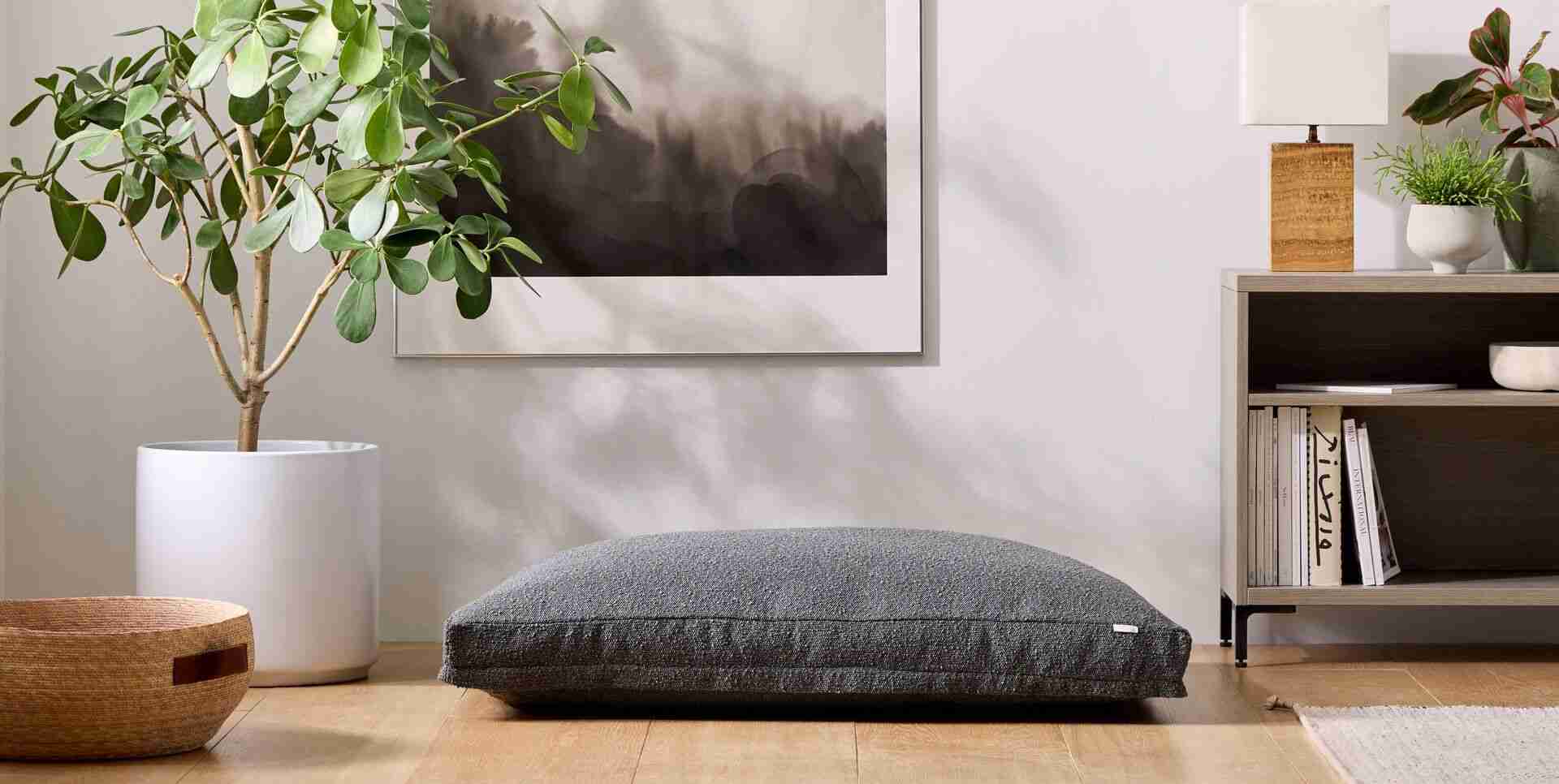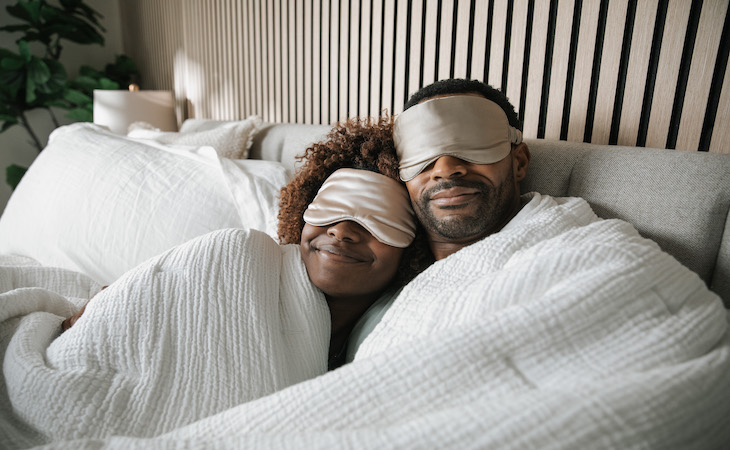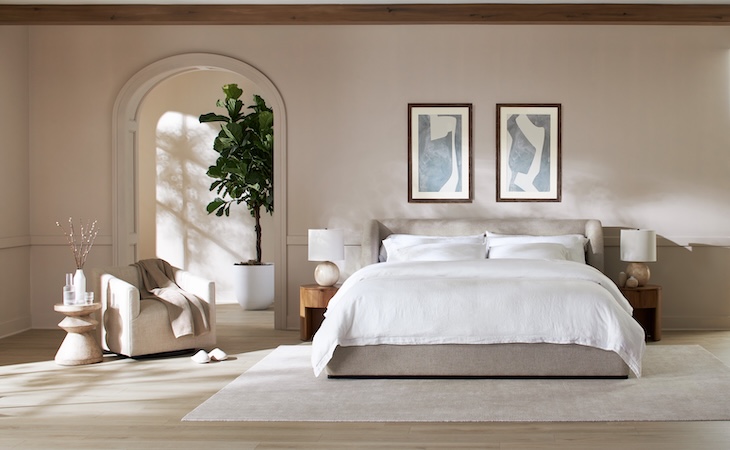In times of stress, many of us look to someone who will be with us through thick and thin—like a warm, fuzzy, comforting pet. It’s no wonder that throughout the pandemic, pet ownership has gone up exponentially. One November 2021 study reported that 14% of United States respondents had gotten a new pet, an increase of 4% since December 2020.
As a result, our minds are on our pets more than ever. In fact, in their annual trend report, Pinterest predicted “barkitecture,” in which people are increasingly incorporating pet-friendly features into their homes, would be one of the biggest interior design trends of 2022.
The bedroom should be no exception when setting up spaces that appeal to your dogs or cats. Whether it’s buying a comfy bed, setting up the room for older pets, or choosing cleaners that won’t be toxic to your furry friends, we’ve got you covered with these seven helpful tips.
Purchase the right pet bed
Choosing a pet bed that’s comfortable and safe for your pup or kitty is key.
First, whatever pet bed you select should be machine-washable or have a cover that can be unzipped and removed to be washed in the laundry, says Amanda Williams, doctor of veterinary medicine and chief veterinarian and medical director of Furry Friends Adoption, Clinic & Ranch in Jupiter, Fla.
Keep in mind that pet beds come in a variety of shapes—and your pet’s behavior can inform which one is right for them.
“Observe your pet’s sleeping habits,” Williams suggests. “If they sleep curled up, get a circular bed. If they are all sprawled out, get a rectangular bed. If they like to lean on their side, get a bed with back support. If your pet likes to snuggle up under the covers, get a bed with a little hood to burrow underneath.”
Pet beds also come in a wide range of materials.
If you live in a cold climate or have a dog or cat who doesn’t have fluffy fur or a lot of meat on their bones, “consider a bed that is plush with fleece, faux fur, or some other material that will keep them warm and cozy,” Williams recommends. “If your dog or cat has a lot of its own insulation and is very furry or you are in a warm climate, look for a bed made of a material that will keep them cool.”
Maybe your pet has orthopedic problems, such as arthritis, hip dysplasia, or injuries. In this case, Williams emphasizes the importance of purchasing an orthopedic bed.
“There are even NASA-certified beds with memory foam to provide your pet with the support they need to rest and reduce strain on the areas causing them pain and discomfort,” she says.
The size of the pet bed is also important. Williams suggests measuring your pet from the tip of their nose to the tip of their tail and then adding 8 to 12 inches to determine the proper length or diameter of their bed.
“Lastly, look for a bed that will grip well to your floor,” Williams says. “If it slides all over the place, it is an accident waiting to happen if your pet gets the zoomies and runs on it or if you accidentally step on it and slip.”
From a design standpoint, Brooke Wilbratte, owner and principal designer of Tribe Design Group, advises choosing a color for the pet bed that “works with your bedroom,” adding that “if you have multiple pets, buy the same ones so they match.”
Just one caveat: If you have a young puppy or kitten who’s still destroying things, you may want to hold off on purchasing a pet bed right now because “you might have to replace it often and you don’t want your pet consuming the fabric or filling,” Williams notes.
Set up their own spot
When you choose a place for the pet bed in your bedroom, Williams suggests opting for a location where it won’t be a tripping hazard, something that Wilbratte thinks is crucial too.
“Do not place a bed in any walkways,” says Wilbratte. “A corner is good or on one side of the bed, preferably the side you don’t see when you walk into the bedroom.” Williams adds that a small nook in a corner or underneath a bench will also make the spot feel “extra cozy and secure” for your pet.
To make the room even more comfortable for your dog or cat, make sure to have an area with food and water available, especially if they’re closed in the bedroom. Scratching posts for cats can help prevent them from scratching at bedroom furniture if confined to the bedroom overnight as well.
What if your dog and cat are sharing the space?
“Have a window perch for the cat bed to be on, which can help the cat feel more comfortable and they can be away from the dog,” says Williams. “A cat tower can also help with an escape area for the cats as well.”
Make the room welcoming
If you want to set up your bedroom in such a way that it’s a safe space for your pets, you can make it more welcoming and accessible to them.
Williams recommends keeping the door open during the day and letting them come and go as they please. “Then, at nighttime, they’ll want to be there when the door is closed,” she says.
Also, keep toys in the bedroom so they have stimulation. “They may wake up in the middle of the night to teethe or want to play,” says Williams. “By having toys there, they can do so without disturbing you.”
Consider special needs
Perhaps your pet is dealing with a mobility issue, a health problem, or is getting up in years and needs a little help getting around. In this instance, you’ll want to accommodate them in your sleeping space.
Williams remarks that senior pets who are accustomed to sleeping on the bed—but can no longer jump on and off—could begin to feel sad, depressed, disconnected from the family, or like they’re being punished if accommodations aren’t made.
So if you prefer your pet sleep in your bed—but they’re unable to jump on or off the bed—it can be useful to buy a ramp or staircase. That way “they can easily climb from the floor to the bed and vice versa,” Williams says. “You do not want a pet injuring themselves or making an active injury worse because they take the risk of jumping.”
Wilbratte offers an alternative to a ramp: “A pretty bench or stools at the foot of the bed can help older, smaller pets get on the bed,” she says. “They are normally 18 inches high, so they’re easier to jump on.”
If your senior pet normally likes to sleep on the floor, Williams says a memory foam or good orthopedic pet bed can help alleviate stiffness and provide comfort.
For dogs who have urinary incontinence and might have breakthrough leaking, Williams says you can consider a bed with a waterproof surface or use pee pads over the bed to control the mess.
Include pet-friendly fabrics
When you have a pet, messes are guaranteed. Since many bedroom fabrics tend to not be particularly stain-resistant, Wilbratte has suggestions for pet-friendly alternatives.
She recommends 100% polyester or 100% solution-dyed acrylic, both of which are very washable fabrics. “There are so many incredible fabrics now that look and feel like velvet, leather, cotton, and linen,” she says.
Think about flooring
When it comes to selecting flooring for your pet-friendly bedroom, Wilbratte sings the praises of wood. She says it’s the best option since most dogs don’t like to walk on tile.
“We prefer wood flooring with an area rug under your bed so if your dog has an accident or ruins the rug somehow, you can get it cleaned or replace it easily,” explains Wilbratte.
Make it safe
Whether your pet spends the majority of their time in your bedroom, or if they’re unattended while you’re sleeping or away at work, it’s important to keep your sleeping space safe. This is something that’s true for every room of your home.
Begin by thinking about the types of cleaning products you’re using.
“Animals explore the world using their senses of smell and taste,” Williams observes. “If a cleaning product has a scent they are attracted to, they are more likely to investigate it by licking it up.”
That’s why Williams suggests using scent-free cleaning products. She says there are also plenty of natural cleaners that are labeled for safe use around animals and are non-harmful if ingested. “Make sure to check the label or call the company hotline for more information when choosing a cleaning product,” she advises.
Williams says ingredients such as bleach, ammonia, chlorine, glycol ethers, and formaldehyde can be toxic and lead to cancer, anemia, and liver and kidney damage in pets.
There are several other ways you can make your bedroom safer for your pet. For starters, keep any choking hazards out of reach. This includes small objects they can swallow, such as jewelry and batteries, as well as cords from blinds that could wrap around their neck, says Williams.
If you tend to keep your medications in your bedroom, make sure your pets can’t get to them either. “Pills are quite attractive to pets,” Williams says.
Williams adds that it’s important to keep electrical wires hidden and unused power outlets plugged in to prevent electrocution. Also, if your pet is prone to jumping on furniture and you’re afraid the furniture might topple to the ground, fasten it to the wall.
Make sure to keep clothes off the floor as they can be tempting for some chewers to ingest overnight and can be a target for cats to urinate. And keep towels, headbands, and ponytail holders out of reach if they like to grab and chew on them.
“The precautions to take to pet-proof a home are identical to baby-proofing,” Williams says.
The bottom line: Pets are generally much happier if they’re near their humans, and spending time in your sleeping space together is an excellent way to do just that. Knowing your pet is comfortable and safe in your home will make you feel a lot better too.
For more information on improving your pet’s—and your own—sleep, check out these other articles on our blog:
- 5 Ways to Keep Your Pet From Ruining Your Sleep
- 6 Ways to Help Your Stressed Pet Get Better Sleep
- How to Sleep Train a New Puppy or Kitten
- The Sleep and Health Benefits of Owning a Pet





